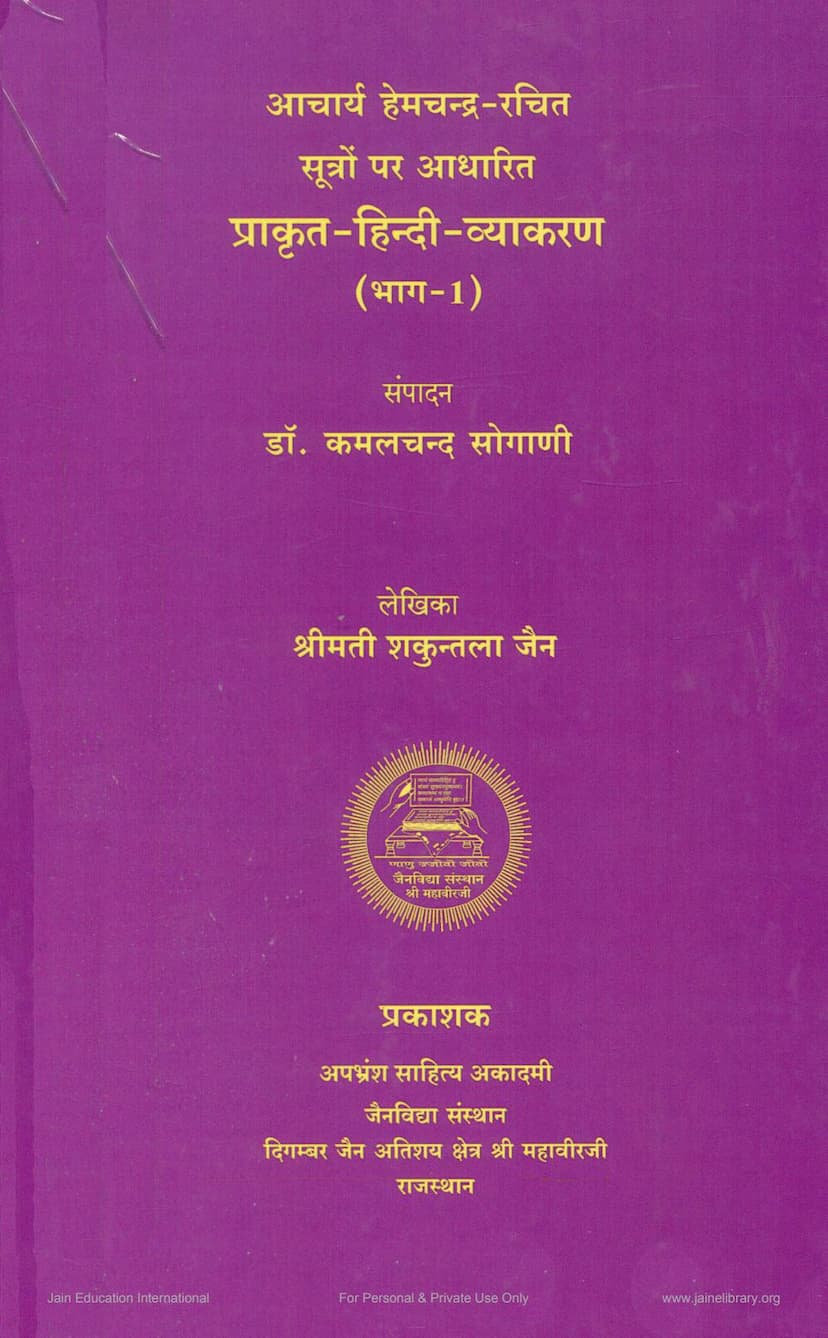Prakrit Hindi Vyakaran Part 01
Added to library: September 2, 2025

Summary
Here's a comprehensive summary of the provided Jain text, "Prakrit Hindi Vyakaran Part 01" by Kamalchand Sogani and Shakuntala Jain:
Book Title: Prakrit Hindi Vyakaran Part 01 (A Prakrit-Hindi Grammar Based on the Sutras of Acharya Hemchandra, Part 1)
Authors: Edited by Dr. Kamalchand Sogani, Written by Shrimati Shakuntala Jain
Publisher: Apbhramsa Sahitya Academy, Jainvidya Sansthan, Shri Mahavirji, Rajasthan
Overview:
This book is a foundational grammar of the Prakrit language, specifically designed to be accessible to Hindi speakers. It aims to simplify the study of Prakrit by explaining its grammatical structures, particularly noun and pronoun declensions, in Hindi. The work is based on the authoritative sutras (aphorisms) of the renowned Jain scholar Acharya Hemchandra, who compiled a comprehensive grammar of Prakrit. The book acknowledges the importance of Prakrit as the language of Tirthankar Mahavir's teachings and as a precursor to modern Indo-Aryan languages.
Key Content and Structure:
The book is structured to systematically introduce the elements of Prakrit grammar. The table of contents (Anukramanika) reveals the following key sections:
- Introduction (Prarambhik): This section likely provides a general introduction to Prakrit language and its significance.
- Prakrit Language - Noun Declensions (Prakrit Bhasha - Sangya Shabdon ka Vibhakti-Vivaran): This is a core part of the book, detailing how nouns change form based on case (vibhaktis), number (vachan), and gender (ling). It covers various types of nouns based on their endings:
- Akārānta (ending in 'a')
- Ākārānta (ending in 'ā')
- Ikārānta (ending in 'i')
- Īkārānta (ending in 'ī')
- Ukārānta (ending in 'u')
- Ūkārānta (ending in 'ū') It systematically presents the declensions for masculine (Pulinga), neuter (Napurisakaliga), and feminine (Strilinga) nouns.
- Prakrit Language - Pronoun Declensions (Prakrit Bhasha - Sarvanam Shabdon ka Vibhakti-Vivaran): This section focuses on the declension of pronouns, which often have unique forms compared to nouns.
- Specific Prakrit Dialects: The book delves into the grammatical peculiarities of different Prakrit dialects, including:
- Sauraseni Prakrit
- Magadhi Prakrit
- Paishachi Prakrit
- Ardhamagadhi Prakrit For each dialect, it highlights specific noun and pronoun declension patterns that differ from the general Prakrit rules.
- Specific Words (Vishisht Shabd): This section addresses nouns and adjectives that have irregular or special declension patterns. Examples include terms for father, mother, king, soul, and doer.
- Appendices (Parishisht):
- Appendix 1: Noun Declension Tables (Sangya Shabdon ki Rupavali): Comprehensive tables summarizing the declensions of various noun types.
- Appendix 2: Specific Word Declension Tables (Vishisht Shabdon ki Rupavali): Tables for the irregular words discussed earlier.
- Appendix 3: Pronoun Declension Tables (Sarvanam Shabdon ki Rupavali): Tables for pronoun declensions.
- Appendix 4: References to Acharya Hemchandra's Sutras (Acharya Hemchandra-rachit Sutron ke Sandarbh): This appendix likely provides the original Prakrit sutras on which the grammatical rules are based, allowing for cross-referencing.
- Appendix 5: Prakrit Vocabulary (Prakrit Shabdavali): A glossary of Prakrit words with their Hindi meanings, categorized by gender.
- Additional Information: The book also includes useful information regarding Prakrit and Apabhramsa grammars, and a bibliography.
Key Grammatical Features Explained:
The book systematically explains the following grammatical aspects of Prakrit:
- Alphabet: A brief mention of Prakrit vowels and consonants, noting the limited use of some sounds in certain contexts.
- Number (Vachan): Prakrit primarily uses two numbers: singular (Ekvachan) and plural (Bahuvachan).
- Gender (Ling): Prakrit has three genders: masculine, neuter, and feminine.
- Person (Purush): Similar to other Indic languages, Prakrit has three persons: first (Uttam Purush), second (Madhyam Purush), and third (Any Purush).
- Case (Vibhakti): Nouns have eight cases, while pronouns have seven (lacking the vocative case). The book details the endings for each case in various contexts.
- Verbs (Kriya): Prakrit verbs are categorized as transitive (Sakarmak) and intransitive (Akarmak).
- Tense (Kaal): Four primary tenses are described: present, past, future, and imperative/subjunctive.
- Word Types (Shabd): Prakrit words are classified based on their final vowel: Akārānta, Ākārānta, Ikārānta, Īkārānta, Ukārānta, and Ūkārānta.
Significance and Approach:
The book is a valuable resource for students of Prakrit, particularly those who are Hindi speakers. Its approach is to simplify complex Sanskrit-based grammatical rules into readily understandable Hindi explanations. This makes Prakrit accessible to a wider audience, enabling them to engage with Jain scriptures and literature that were often composed in Prakrit. The editors and authors emphasize their commitment to making the study of ancient languages approachable and relevant. The book's publication by the Jainvidya Sansthan and Apbhramsa Sahitya Academy highlights its connection to the preservation and promotion of Jain heritage and literature.